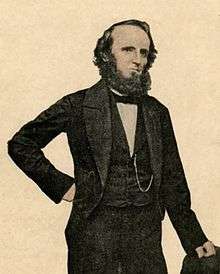Gamaliel Bailey

Gamaliel Bailey (December 3, 1807 – June 5, 1859) was an American journalist, editor and publisher, working primarily in Cincinnati, and Washington, D.C. An abolitionist, he supported journalism that promoted the cause, persisting despite violent mob attacks on his offices in both cities during the 1840s.
Biography
Born and raised in Mount Holly Township, New Jersey in 1807, Bailey moved with his family to Philadelphia at the age of nine.[1] He was educated at home and in local schools.
Bailey graduated from the Jefferson Medical College, Philadelphia, in 1827. He moved to Baltimore, where he served as editor of the Methodist Protestant, a religious journal.
In 1831, Bailey moved to Cincinnati, where he set up a medical practice. He also lectured on physiology at the Lane Theological Seminary. Attending the Lane Seminary debates in February 1834 between pro-slavery and the anti-slavery students, he became an ardent abolitionist. The anti-slavery students withdrew from the seminary in protest for its refusal to condemn slavery.
In 1836, Bailey joined James G. Birney in the editorial control of the Philanthropist; the following year he succeeded Birney as editor. He directed the paper in publishing anti-slavery articles until 1847, in spite of threats and acts of violence–the printing office of the Philanthropist was wrecked three times by pro-slavery mobs.
Beginning in 1843, Bailey also edited a daily paper, the Herald. In 1847 he assumed control of the new abolitionist publication, the National Era, in Washington, D.C. His offices were attacked by pro-slavery mobs; in 1848, he and his printers were under siege for three days as a mob held them hostage. This paper had a considerable circulation nationally. In 1851—1852, it published Harriet Beecher Stowe's novel, Uncle Tom's Cabin, in serial form.
In 1859, Bailey died at the age of 51 at sea aboard the steamship Arago while en route to Europe.[2] His body was originally buried in Congressional Cemetery in Washington, D.C. His wife, Margaret, died in 1888 and was buried at Oak Hill Cemetery, across the city. Bailey's son, Marcellus, had his father's remained disinterred and reburied in an unmarked grave next to Margaret.
References
- ↑ Folsom & Ogden 1921, p. 321.
- ↑ Folsom & Ogden 1921, p. 322.
Bibliography
 Chisholm, Hugh, ed. (1911). "Bailey, Gamaliel". Encyclopædia Britannica (11th ed.). Cambridge University Press.
Chisholm, Hugh, ed. (1911). "Bailey, Gamaliel". Encyclopædia Britannica (11th ed.). Cambridge University Press.- Folsom, Joseph Fulford; Ogden, Mary Depue (1921). Cyclopedia of New Jersey Biography, Memorial and Biographical. New York: American Historical Society.
- Harrold, Stanley (1986). Gamaliel Bailey and Antislavery Union. Kent, Ohio: Kent State University Press. ISBN 087338329X.